This article needs additional citations for verification .(January 2018) |
Albert Philippot (1899, Couillet, Charleroi - 1974, Woluwe-Saint-Pierre, Brussels) was a Belgian painter and art restorer. [1]
This article needs additional citations for verification .(January 2018) |
Albert Philippot (1899, Couillet, Charleroi - 1974, Woluwe-Saint-Pierre, Brussels) was a Belgian painter and art restorer. [1]
He entered the Brussels Academy in 1918 and was initially influenced by his tutors Jean Delville and Constant Montald, though in a vein that was more lyrical than intellectual. [2] In the 1920s he produced large decorative works in tempera as well as developing his oil technique between 1926 and 1930 on portraits, nudes, interiors and landscapes. He also drew on old masters and their techniques, influencing his own work as well as his restorations.
His studio was set on fire by a bomb in 1944, destroying most of his oeuvre, leading him to abandon painting to concentrate on restoration, in which he had been trained by his father-in-law Jef Van der Veken. He did still produce oil studies and brown chalk drawings until around 1950, mainly portraits and landscapes.

Chaïm Soutine was a French painter of Belarusian-Jewish origin who made a major contribution to the expressionist movement while living and working in Paris.

Francis Picabia was a French avant-garde painter, writer, filmmaker, magazine publisher, poet, and typographist closely associated with Dada.
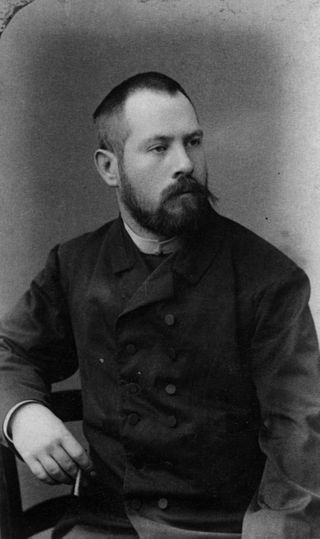
Lovis Corinth was a German artist and writer whose mature work as a painter and printmaker realized a synthesis of impressionism and expressionism.

Early Netherlandish painting, is the body of work by artists active in the Burgundian and Habsburg Netherlands during the 15th- and 16th-century Northern Renaissance period, once known as the Flemish Primitives. It flourished especially in the cities of Bruges, Ghent, Mechelen, Leuven, Tournai and Brussels, all in present-day Belgium. The period begins approximately with Robert Campin and Jan van Eyck in the 1420s and lasts at least until the death of Gerard David in 1523, although many scholars extend it to the start of the Dutch Revolt in 1566 or 1568–Max J. Friedländer's acclaimed surveys run through Pieter Bruegel the Elder. Early Netherlandish painting coincides with the Early and High Italian Renaissance, but the early period is seen as an independent artistic evolution, separate from the Renaissance humanism that characterised developments in Italy. Beginning in the 1490s, as increasing numbers of Netherlandish and other Northern painters traveled to Italy, Renaissance ideals and painting styles were incorporated into northern painting. As a result, Early Netherlandish painters are often categorised as belonging to both the Northern Renaissance and the Late or International Gothic.

Paul-Albert Besnard was a French painter and printmaker.

Neo-Impressionism is a term coined by French art critic Félix Fénéon in 1886 to describe an art movement founded by Georges Seurat. Seurat's most renowned masterpiece, A Sunday Afternoon on the Island of La Grande Jatte, marked the beginning of this movement when it first made its appearance at an exhibition of the Société des Artistes Indépendants in Paris. Around this time, the peak of France's modern era emerged and many painters were in search of new methods. Followers of Neo-Impressionism, in particular, were drawn to modern urban scenes as well as landscapes and seashores. Science-based interpretation of lines and colors influenced Neo-Impressionists' characterization of their own contemporary art. The Pointillist and Divisionist techniques are often mentioned in this context, because they were the dominant techniques in the beginning of the Neo-Impressionist movement.
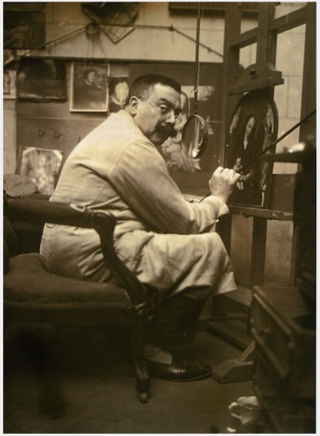
Josephus Maria Van der Veken was a Belgian art restorer, copyist, and art forger who mastered the art of reproducing the works of early Netherlandish painters.

Théophile "Théo" van Rysselberghe was a Belgian neo-impressionist painter, who played a pivotal role in the European art scene at the turn of the twentieth century.

Jean Delville, born Jean Libert, was a Belgian symbolist painter, author, poet, polemicist, teacher, and Theosophist. Delville was the leading exponent of the Belgian Idealist movement in art during the 1890s. He held, throughout his life, the belief that art should be the expression of a higher spiritual truth and that it should be based on the principle of Ideal, or spiritual Beauty. He executed a great number of paintings during his active career from 1887 to the end of the second World War expressing his Idealist aesthetic. Delville was trained at the Académie des Beaux-arts in Brussels and proved to be a highly precocious student, winning most of the prestigious competition prizes at the Academy while still a young student. He later won the Belgian Prix de Rome which allowed him to travel to Rome and Florence and study at first hand the works of the artists of the Renaissance. During his time in Italy he created his celebrated masterpiece L'Ecole de Platon (1898), which stands as a visual summary of his Idealist aesthetic which he promoted during the 1890s in his writings, poetry and exhibitions societies, notably the Salons d'Art Idéaliste.
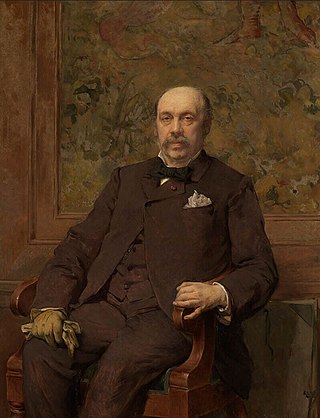
Jean-François Portaels or Jan Portaels was a Belgian painter of genre scenes, biblical stories, landscapes, portraits and orientalist subjects. He was also a teacher and director of the Academy of Fine Arts of Ghent and the Académie Royale des Beaux-Arts in Brussels. He is regarded as the founder of the Belgian Orientalist school. He was praised in his time as the premier painter of 'everyday elegance and feminine grace'. Through his art, teaching and his leadership of the Académie Royale in Brussels he exerted an important influence on the next generation of Belgian artists, including his pupil Théo van Rysselberghe.
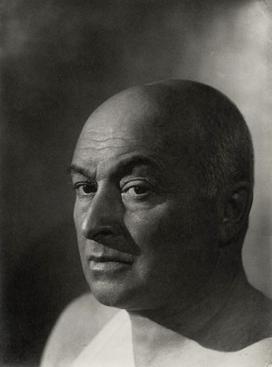
Louis Marcoussis, formerly Ludwik Kazimierz Wladyslaw Markus or Ludwig Casimir Ladislas Markus, was a Polish-French avant-garde painter active primarily in Paris. Markus studied law in Warsaw before attending the Kraków Academy of Fine Arts, and later moved to Paris to study under Jules Lefebvre at the Académie Julian. His work was first featured in a major exhibition at the Salon d'Automne in 1905. In Paris, he became acquainted with prominent artists and writers in the cafes of Montmartre and Montparnasse.

Cornelis de Vos was a Flemish painter, draughtsman and art dealer. He was one of the leading portrait painters in Antwerp and is best known for his sensitive portraits, in particular of children and families. He was also successful in other genres including history, religious and genre painting. He was a regular collaborator with Rubens.
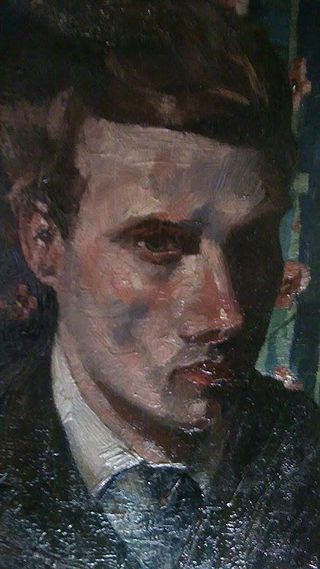
John Quinton Pringle was a Scottish painter, influenced by Jules Bastien-Lepage and associated with the Glasgow Boys.

Emile Albert Gruppé (1896–1978) was an American painter, known for impressionistic landscapes and Massachusetts coastal and marine paintings.

An oil sketch or oil study is an artwork made primarily in oil paint in preparation for a larger, finished work. Originally these were created as preparatory studies or modelli, especially so as to gain approval for the design of a larger commissioned painting. They were also used as designs for specialists in other media, such as printmaking or tapestry, to follow. Later they were produced as independent works, often with no thought of being expanded into a full-size painting.

Antoon Sallaert or Anthonis Sallaert (1594–1650) was a Flemish Baroque painter, draughtsman and printmaker who was active in Brussels. Sallaert produced many devotional paintings for the Brussels court of Archdukes Albert and Isabella as well as for the local churches. Sallaert was an innovative printmaker and is credited with the invention of the monotype technique. He was an important tapestry designer for the local weaving workshops.
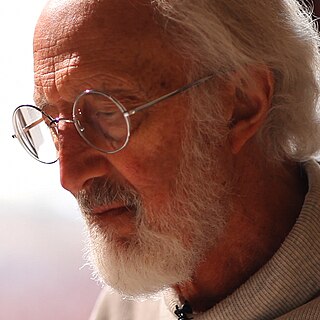
Pierre Cordier is a Belgian artist. He is considered to be a pioneer of the chemigram and of its development as a means of artistic expression.

Fernand Toussaint (1873–1956) was a Belgian painter and illustrator in the 19th century Belgian School. He was born in Brussels in 1873 in a family of upper-middle class. When his parents discovered his talent in drawing they helped him to develop it in full.
René Victor Gustave Joseph Sneyers was a Belgian chemist. He succeeded Paul B. Coremans as head of the Institut royal du patrimoine artistique (IRPA).
Albert Chiarandini was an Italian-Canadian painter most closely associated with Group of Seven in his art.